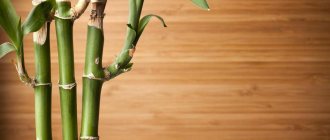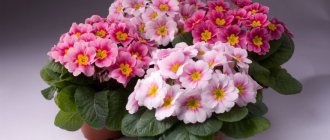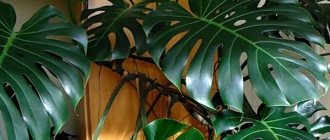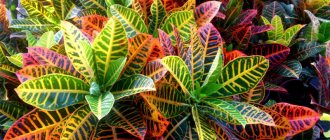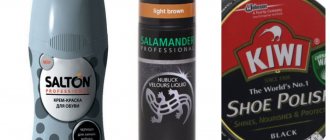There are some plants that immediately attract attention. In any flower arrangements, they have a solo part prepared in advance. Schefflera is exactly such a plant. Her strength lies not only in her striking beauty, but also in her special energy .
It absorbs negativity from the environment, helps you relax and unwind. It also purifies the air. An unpretentious plant is a welcome guest in any home . But what is this flower and how does it reproduce at home?
general information
The most characteristic feature of Schefflera (pictured) is its unusual leaves. They have a finger-complex structure. Each leaf consists of several lobes.
They can be oval or pointed. Externally they resemble fingers . Each slice meets the others in the center. The presence of thin petioles makes the leaf look like a smaller copy of an umbrella.
The height of shefflera in its natural environment reaches from 4 to 6 m, and the lush crown in volume reaches 1.5 m. A miracle of nature is budding . Paniculate peduncles are painted in various shades. Later, berries appear in their place. Seeds are obtained from them. In indoor conditions, the formation of flowers is a very rare occurrence.
Possible problems
When growing sheflera, gardeners may encounter some problems. Often, if grown and cared for improperly, the flower is attacked by pests:
- Spider mite. The plant is covered with a thin web. White-yellow blotches are visible on the leaf. To destroy the pest, the leaves are washed with soapy water, and then the preparations Actellik and Fitoverm are used.
- Greenhouse aphid. The insect is dangerous because it sucks the juice from the plant. The leaves turn orange, then curl and fall off. The drugs Actellik and Fufanon are used against aphids.
As a preventive measure, the leaves can be wiped with soapy water and the flower can be given a warm shower.
If planted and cared for incorrectly, the flower may encounter the following problems:
- Powdery mildew. The leaf blade is covered with a white powder-like coating. If you look closely, you can see small ulcers from which fluid is released. The leaves begin to wither, dry out and fall off. You can get rid of powdery mildew using systemic fungicides.
- Rust. This disease affects stems and leaves. A sign of the disease is clusters of orange or brown spores on the underside of the plate, yellow oval or round spots on the top. Then the spots turn into brown stripes and the leaves fall off. Eliminate the disease with chemicals: Topaz, Abiga-Pik, Baktofit.
- Gray rot. The main reason for the appearance is the presence of the flower in a cold, damp room. The disease can be detected by a gray coating on the leaf. Infected leaves are removed, and the plant itself is treated with chemicals such as Fundazol.
- Bacterial spotting. Watery, glassy spots appear on the undersides of the leaves and turn dark brown over time. It is impossible to cure the plant; it should be disposed of along with the soil, and the pot should be disinfected.
Falling leaves
It happens that the leaves turn yellow and the plant begins to shed its foliage en masse. Why do Schefflera leaves fall? This is often due to dry indoor air.
If a problem is detected, you need to check the soil in the pot, it should be moist. Drying out the soil slows down the growth of the leaf blade, it weakens and falls off. The fall of variegated foliage can be caused by a lack of light. Too wet soil can also cause leaf shedding.
Blackening of leaves
When the root rots, the leaves of the flower begin to turn black. This happens when you water too often.
Black leaves on Schefflera
The flower is removed from the pot and the damaged roots are carefully removed. Afterwards they need to be sprinkled with crushed coal and dried.
Important! If the bush is exposed to a draft for a long time, it can catch a cold. The leaves turn black and fall off. The leaf blade becomes covered with spots after exposure to sunlight. Yellow leaves indicate the presence of pests.
If you adhere to the rules of care and planting, you can easily grow sheflera at home. It is believed that even a novice lover of indoor flowers can cope with this.
Schefflera: description and origin, photo
This beauty represents the Araliev family. The most popular varieties are wood shefflera. Its habitat is tropical forests in Southeast Asia.
These plants are also very common in Indonesia and the Malay Archipelago . There are about 200 species of Schefflera in the wild, but there are no more than a dozen ornamental species.
Four types are best suited for indoor floriculture:
- Palmate. The oval-shaped leaves consist of 7–10 elongated “fingers” with long petioles. There are bright veins. The bush itself is quite compact.
- Radifolia. This species is also called star-shaped. It is distinguished by large leaves (about 15 cm long). They have a rich green tint.
- Tree-like. Its characteristic feature is the complex structure of the leaves. They are glossy and quite dense. The bush reaches 1.2 meters in length. There are both green and variegated varieties.
- Eight-leaved. A very rare species. But it has already gained popularity among flower growers. The leaf length reaches 30 cm, and the width is about 10 cm. The surface is decorated with light veins.
This video shows some types of Schefflera and gives recommendations for caring for the plant.
We analyze the results and choose the best method of propagating sheflera
In the soil, the shefflera produced strong roots a week earlier than in water, so the next time when propagating the shefflera, I will immediately plant the cuttings in a tall, narrow pot or glass, and will not root in water.
Regarding rooting using air outlets, I can say that this method is worth considering if you need to trim the plant and root a large top with a woody trunk. However, my experiment showed that in order to force more roots, it is worth stripping a longer section (at least 4 cm) in order to capture several growth points. The ability to use air outlets can also be useful with other indoor and garden plants; I wrote about my experience with Ficus Benjamin here.
Schefflera: propagation at home
Like many other plants, Schefflera can be propagated by two methods: vegetative and generative.
Seeds
Planting material can be easily purchased at the store. It is almost impossible to obtain seeds yourself . They are planted in January or February. By the arrival of calendar spring, the plant obtained from seeds will have time to grow stronger and adapt to environmental conditions.
Advice! They are first kept in warm water or epin solution (no longer than a day). Then they take wide containers with high walls and fill them with fertile and light soil. Boxes are quite suitable for these purposes. The seeds are buried approximately 5 mm.
After this, the soil is moistened and the containers are sealed with film. Having an improvised greenhouse is mandatory .
Caring for seedlings is simple. It is enough to put them in a bright place, regularly ventilate them and spray them with warm water from a small spray bottle. Sprouts with a pair of clear leaves can be picked.
Instructions for propagation by cuttings
Cuttings are carried out most often. There are two ways to achieve the appearance of roots on the stems: by placing them in a container with water or directly in the soil.
Cuttings in water
For this method it is better to use root cuttings . A transparent jar or any other container is filled with water. Then the plant is placed.
Note! To prevent rotting, it is useful to add charcoal or activated carbon; root can also be used.
The cutting that has already begun to become lignified and has several rosettes of leaves will take root faster. You will have to wait about three weeks . When the roots grow a couple of centimeters, you can transplant the schefflera into the ground.
Rooting cuttings with leaves in the ground
They are harvested in the spring or at the very beginning of summer. The optimal length of the cutting is from 5 to 10 cm. Before taking the shoot, the instrument must be disinfected. The cut site must be treated with special preparations . You can choose from succinic acid, heteroauxin or root.
Advice! The best substrate for rooting is nutritious soil or wet sand. Drainage is very important. Pots with cuttings are covered with a cap made of a regular plastic bag.
Now it is necessary to ensure a constant temperature within + 21–24 degrees. Periodically, the plant requires access to fresh air.
Leaf propagation technology
It can be difficult to achieve a positive result when rooting by leaf. It doesn't always take root . A medium-sized plate must be carefully separated from an adult plant along with the growth zone. It is a growth located between the base of the leaf and the stem.
Add growth stimulants to the settled water and place planting material in them. It's better to take several. Now the vessel needs to be wrapped in film and left warm.
Important! With the appearance of roots, it is time to move the leaf into a preheated substrate. Maintain greenhouse conditions. After a while, begin to ventilate the plantings and introduce moisture into the ground.
Air layering
Propagation of shefflera from an adult flower is the simplest. The mother plant must be mature and absolutely healthy. A cut is made on the non-main stem . They wrap it around it successively with moss, cotton wool and film.
Layers of moss and cotton wool are regularly moistened. The process of roots appearing will take approximately 1.5 months. The resulting air layering must be separated along with the stem. Next they are placed in a pot with suitable soil .
This video shows how to propagate Schefflera from cuttings.
Transfer rules
For the first 3-4 years, shefflers are replanted annually in the spring. Adult plants need to increase the volume of the pot every 2-3 years. Large plants (1 m or more in height) are difficult to replant, so they limit themselves to partial replacement of the soil. Care for transplanted plants as usual.
Transplantation of cuttings is carried out according to the rules:
- Take the first pot of small volume (150-200 ml), preferably transparent, in order to control the development of the root system.
- When the earthen lump is completely entwined with roots, the young sheflera is transferred to a larger container, increasing the volume by no more than 150 ml.
- If the pot is too large, the growth of the flower will stop until the roots have mastered the soil. In total, in the first year 2-3, or less often 4, transplants of a young plant are done.
Interesting! Some peoples believe that sheflera is capable of predicting unpleasant events. Thus, the unexpected shedding of foliage by a healthy flower foreshadows a serious illness, or even the death of a loved one, or financial difficulties. Leaves twisted into a tube warn of approaching family conflicts.
General rules of care
The plant will need intense indirect light. On summer days, the flower is taken outside , shading it from the scorching sun. For decorative species, proper lighting plays a special role.
Important! In winter, shefflera is kept at +13–16 degrees (but not lower than +12), and in summer a temperature of +18 to +22 degrees is considered normal. If it rises higher, growth slows down.
The plant is contraindicated in the proximity of heating devices, air conditioners, as well as drafts. It is necessary to maintain high air humidity by spraying. Fertilizers begin to be applied in the spring and are done until the last days of July (approximately every 2-4 weeks).
Pests
Schefflera is attacked by pests of indoor plants such as spider mites, thrips and scale insects. Spider mites are noticeable by a white coating on the leaves and internodes, similar to small cobwebs. The scale leaves a sticky coating, and the insects themselves can be seen in the form of small brown tubercles on the leaves. Thrips can be detected by black dots on the back of the leaf blade.
Spider mite Thrips
Shchitovka
If the number of pests is small, you can use traditional methods:
- wash the leaves with soapy water;
- soak a cotton swab in alcohol and wipe the leaves where insects are found.
If these methods do not lead to the destruction of pests, then it is necessary to treat the plants with insecticides such as Aktara. After a week and a half, the treatment should be repeated.
Choosing a pot
When transplanting, a new container should be taken a couple of centimeters larger than the previous one. In the case of adult specimens - by 5–6 cm. It is better if the pot is in the shape of a trapezoid or tulip . You can place several plants in one container.
Plant such a flower in your apartment, and it will not only decorate any interior, but will also become a kind of talisman for its owner: it will help open new horizons and bring good luck.
This video shows how to properly transplant Schefflera.
Trimming Features
Primrose propagation: basic methods and examples at home
Schefflera grows very quickly, so it needs regular pruning. If you do not do this, the plant will grow to the ceiling. This procedure not only gives the plant its shape, but also protects it from pests.
If pruning is done correctly, new branches will soon appear on the plant.
There are two types of pruning:
- crown formation;
- removing weak and yellow leaves.
For lush branching and a thick crown of the tree, it is necessary to cut off the top. It is advisable to prune in the spring, as soon as the plant wakes up after winter hibernation.
Trimming serves several functions:
- Gives the flower the desired shape.
- Has a beneficial effect on the growth of new branches and leaves.
- Serves as a source of planting material.
- Removes weak and diseased branches.
Important! When a bush loses all its leaves, it can be saved by low pruning.
Growing sheflera from seeds
Seeds are planted in February in a peat-sand mixture (a share of each). They can be soaked before sowing. After sowing, the soil is moistened and kept in a warm place (about 22°C).
Do not forget to sometimes ventilate and water the seedlings a little. When a couple of leaves grow, you can plant the seedlings in pots. For the first couple of months, keep the temperature close to 20°C.
The next transplant is carried out when the roots occupy the entire space of the pot. After this, the temperature must be lowered to 15°C. In the fall, the shefflera is transplanted into a permanent pot.
to contents
Lighting
Schefflera is moderately demanding of good lighting and will happily extend its palm-shaped leaves to the light. The ideal window is southern, acceptable are western and eastern.
Advice: if you want to have this plant, but the room is annoyingly dark, or the pot will be located not on the window, but in the back of the room, choose green rather than variegated types of schefflera. Variegated Schefflera have higher light requirements than regular green ones.
In the summer, the plant will be comfortable moving into fresh air. Watch out for scorching rays: they can burn the leaves, so take care of shading the bush during the active time of the sun.
